The Influence of Gender on Mathematics Performance in TVET Colleges
VerifiedAdded on 2020/07/22
|5
|1668
|45
Literature Review
AI Summary
This literature review examines the multifaceted influence of gender on mathematics performance within Technical and Vocational Education and Training (TVET) Colleges. It synthesizes research exploring the complex interplay of cognitive, social, and environmental factors. The review highlights various perspectives, including cognitive differences (such as brain lateralization and spatial skills), the role of self-efficacy and mathematics anxiety, and the impact of socioeconomic status, school environment, and teacher behavior. It delves into the documented gender differences in mathematics achievement, analyzing how learning styles, curriculum design, and societal stereotypes can contribute to these disparities. Furthermore, the literature review discusses the importance of addressing these issues through instructional procedures and creating a more equitable learning environment for both genders, ultimately aiming to identify the factors that influence mathematics performance and suggest strategies for improvement within TVET colleges.
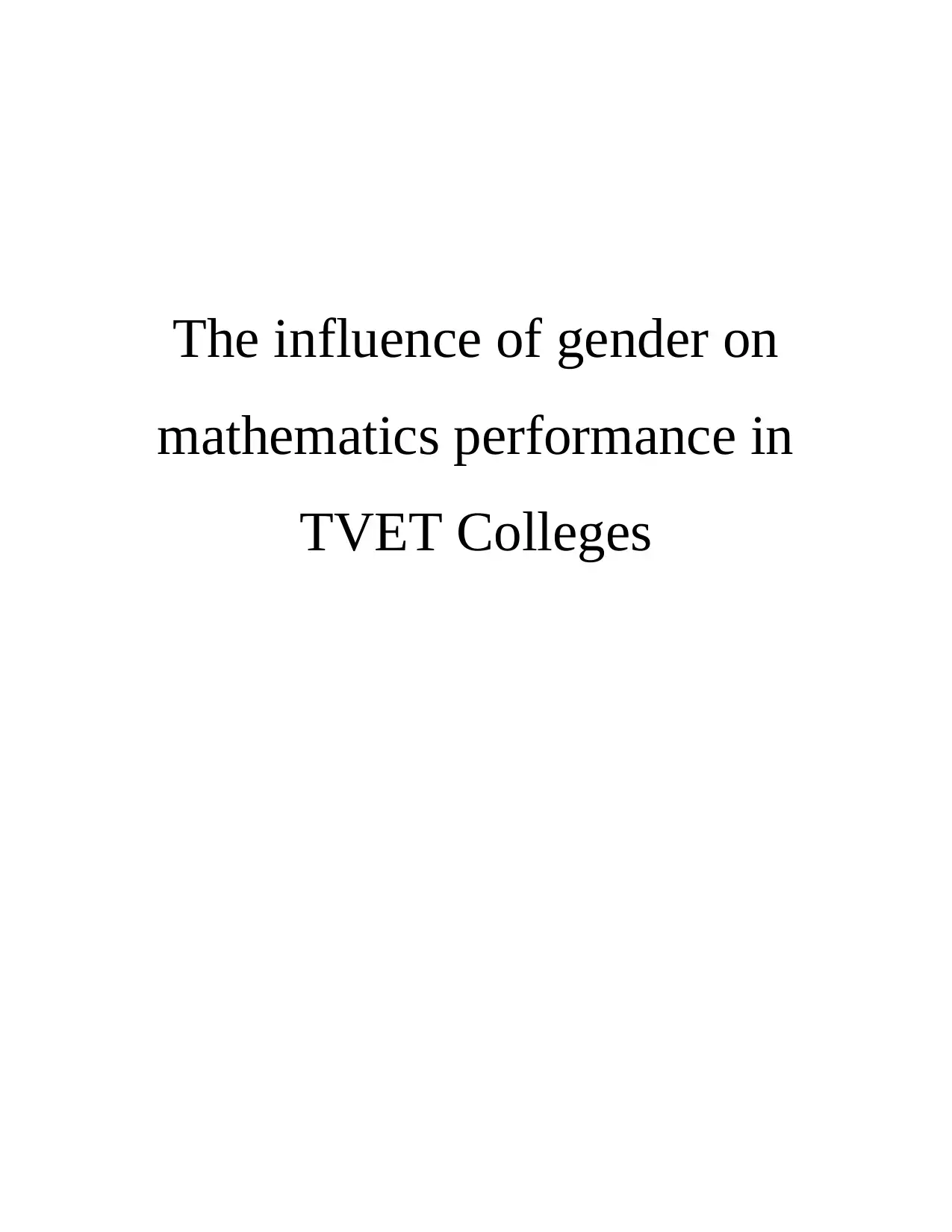
The influence of gender on
mathematics performance in
TVET Colleges
mathematics performance in
TVET Colleges
Paraphrase This Document
Need a fresh take? Get an instant paraphrase of this document with our AI Paraphraser
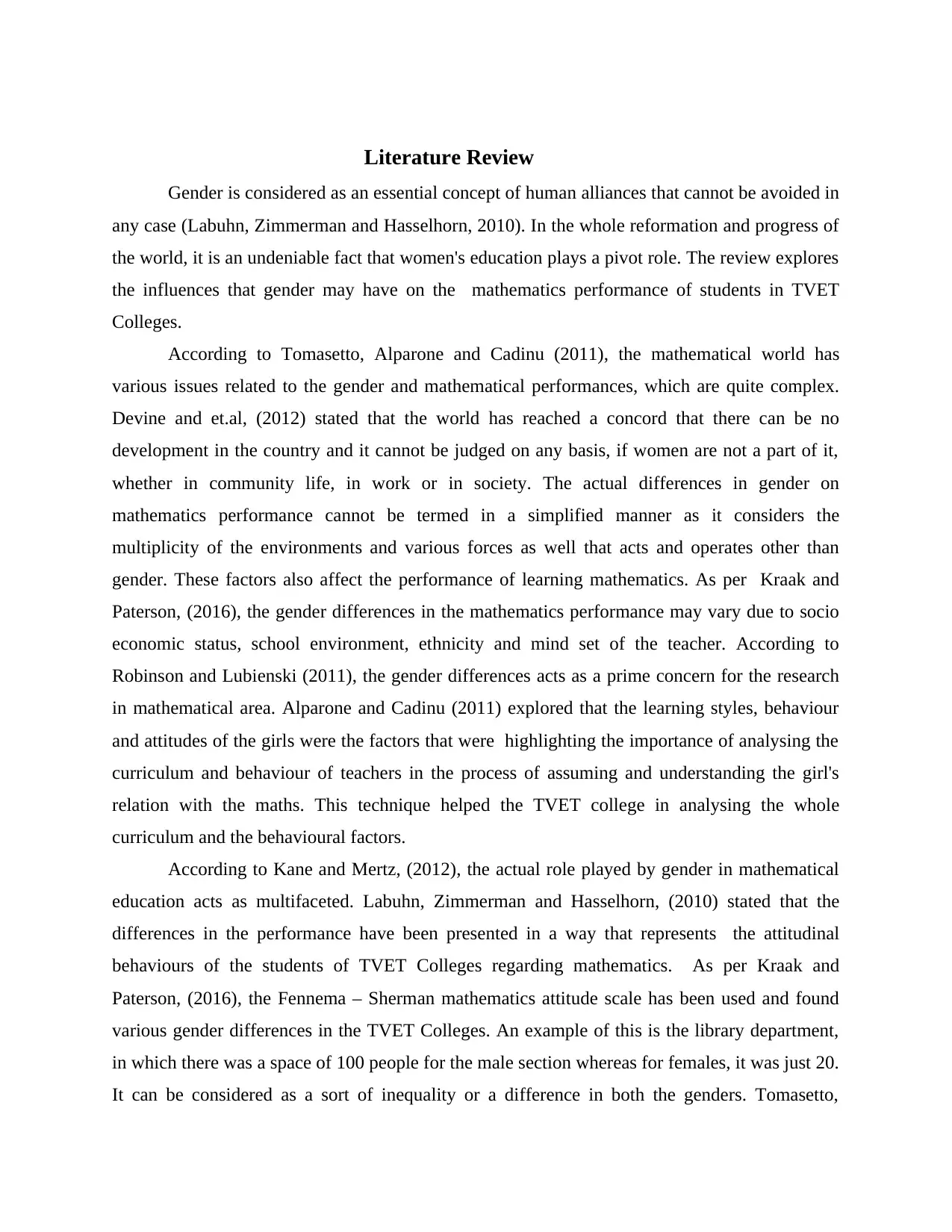
Literature Review
Gender is considered as an essential concept of human alliances that cannot be avoided in
any case (Labuhn, Zimmerman and Hasselhorn, 2010). In the whole reformation and progress of
the world, it is an undeniable fact that women's education plays a pivot role. The review explores
the influences that gender may have on the mathematics performance of students in TVET
Colleges.
According to Tomasetto, Alparone and Cadinu (2011), the mathematical world has
various issues related to the gender and mathematical performances, which are quite complex.
Devine and et.al, (2012) stated that the world has reached a concord that there can be no
development in the country and it cannot be judged on any basis, if women are not a part of it,
whether in community life, in work or in society. The actual differences in gender on
mathematics performance cannot be termed in a simplified manner as it considers the
multiplicity of the environments and various forces as well that acts and operates other than
gender. These factors also affect the performance of learning mathematics. As per Kraak and
Paterson, (2016), the gender differences in the mathematics performance may vary due to socio
economic status, school environment, ethnicity and mind set of the teacher. According to
Robinson and Lubienski (2011), the gender differences acts as a prime concern for the research
in mathematical area. Alparone and Cadinu (2011) explored that the learning styles, behaviour
and attitudes of the girls were the factors that were highlighting the importance of analysing the
curriculum and behaviour of teachers in the process of assuming and understanding the girl's
relation with the maths. This technique helped the TVET college in analysing the whole
curriculum and the behavioural factors.
According to Kane and Mertz, (2012), the actual role played by gender in mathematical
education acts as multifaceted. Labuhn, Zimmerman and Hasselhorn, (2010) stated that the
differences in the performance have been presented in a way that represents the attitudinal
behaviours of the students of TVET Colleges regarding mathematics. As per Kraak and
Paterson, (2016), the Fennema – Sherman mathematics attitude scale has been used and found
various gender differences in the TVET Colleges. An example of this is the library department,
in which there was a space of 100 people for the male section whereas for females, it was just 20.
It can be considered as a sort of inequality or a difference in both the genders. Tomasetto,
Gender is considered as an essential concept of human alliances that cannot be avoided in
any case (Labuhn, Zimmerman and Hasselhorn, 2010). In the whole reformation and progress of
the world, it is an undeniable fact that women's education plays a pivot role. The review explores
the influences that gender may have on the mathematics performance of students in TVET
Colleges.
According to Tomasetto, Alparone and Cadinu (2011), the mathematical world has
various issues related to the gender and mathematical performances, which are quite complex.
Devine and et.al, (2012) stated that the world has reached a concord that there can be no
development in the country and it cannot be judged on any basis, if women are not a part of it,
whether in community life, in work or in society. The actual differences in gender on
mathematics performance cannot be termed in a simplified manner as it considers the
multiplicity of the environments and various forces as well that acts and operates other than
gender. These factors also affect the performance of learning mathematics. As per Kraak and
Paterson, (2016), the gender differences in the mathematics performance may vary due to socio
economic status, school environment, ethnicity and mind set of the teacher. According to
Robinson and Lubienski (2011), the gender differences acts as a prime concern for the research
in mathematical area. Alparone and Cadinu (2011) explored that the learning styles, behaviour
and attitudes of the girls were the factors that were highlighting the importance of analysing the
curriculum and behaviour of teachers in the process of assuming and understanding the girl's
relation with the maths. This technique helped the TVET college in analysing the whole
curriculum and the behavioural factors.
According to Kane and Mertz, (2012), the actual role played by gender in mathematical
education acts as multifaceted. Labuhn, Zimmerman and Hasselhorn, (2010) stated that the
differences in the performance have been presented in a way that represents the attitudinal
behaviours of the students of TVET Colleges regarding mathematics. As per Kraak and
Paterson, (2016), the Fennema – Sherman mathematics attitude scale has been used and found
various gender differences in the TVET Colleges. An example of this is the library department,
in which there was a space of 100 people for the male section whereas for females, it was just 20.
It can be considered as a sort of inequality or a difference in both the genders. Tomasetto,
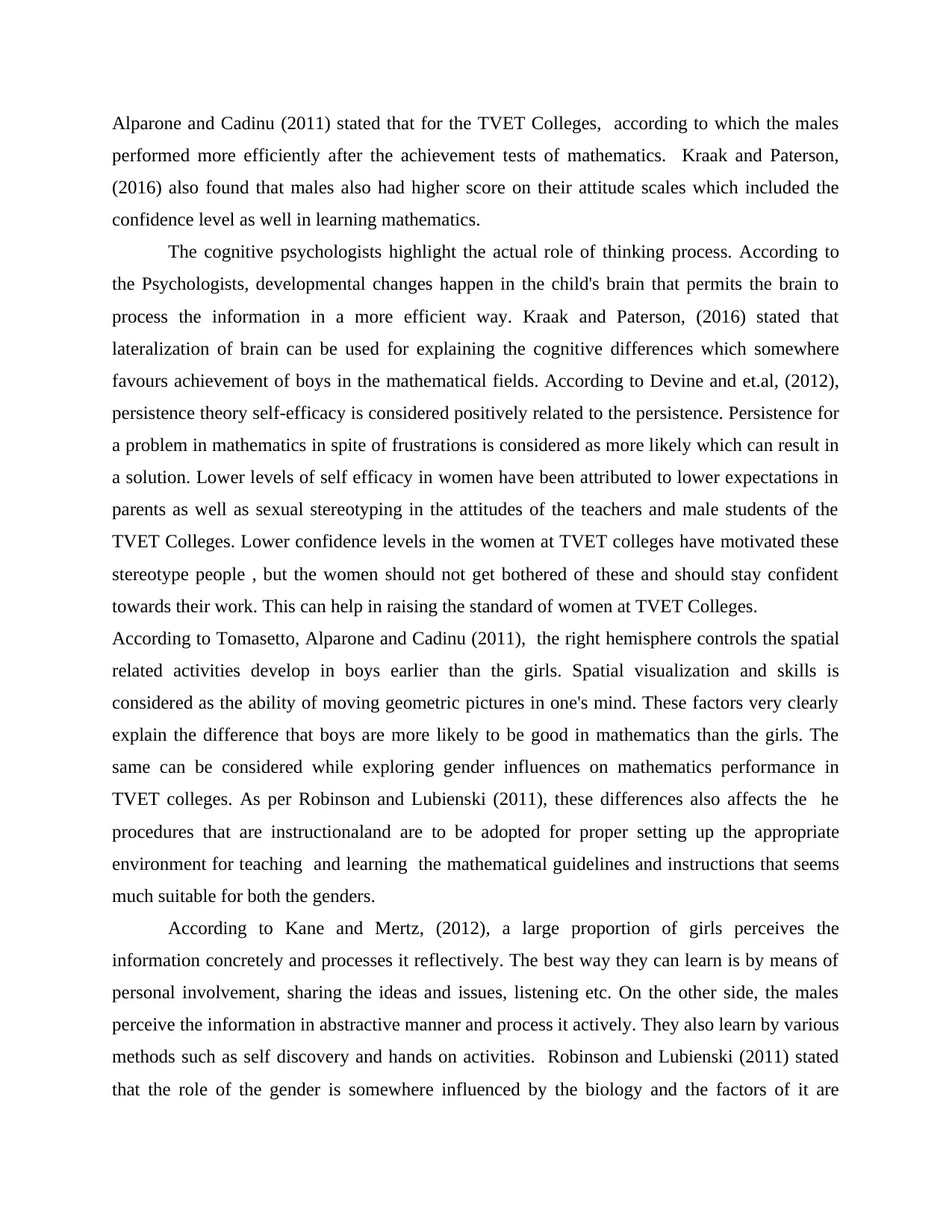
Alparone and Cadinu (2011) stated that for the TVET Colleges, according to which the males
performed more efficiently after the achievement tests of mathematics. Kraak and Paterson,
(2016) also found that males also had higher score on their attitude scales which included the
confidence level as well in learning mathematics.
The cognitive psychologists highlight the actual role of thinking process. According to
the Psychologists, developmental changes happen in the child's brain that permits the brain to
process the information in a more efficient way. Kraak and Paterson, (2016) stated that
lateralization of brain can be used for explaining the cognitive differences which somewhere
favours achievement of boys in the mathematical fields. According to Devine and et.al, (2012),
persistence theory self-efficacy is considered positively related to the persistence. Persistence for
a problem in mathematics in spite of frustrations is considered as more likely which can result in
a solution. Lower levels of self efficacy in women have been attributed to lower expectations in
parents as well as sexual stereotyping in the attitudes of the teachers and male students of the
TVET Colleges. Lower confidence levels in the women at TVET colleges have motivated these
stereotype people , but the women should not get bothered of these and should stay confident
towards their work. This can help in raising the standard of women at TVET Colleges.
According to Tomasetto, Alparone and Cadinu (2011), the right hemisphere controls the spatial
related activities develop in boys earlier than the girls. Spatial visualization and skills is
considered as the ability of moving geometric pictures in one's mind. These factors very clearly
explain the difference that boys are more likely to be good in mathematics than the girls. The
same can be considered while exploring gender influences on mathematics performance in
TVET colleges. As per Robinson and Lubienski (2011), these differences also affects the he
procedures that are instructionaland are to be adopted for proper setting up the appropriate
environment for teaching and learning the mathematical guidelines and instructions that seems
much suitable for both the genders.
According to Kane and Mertz, (2012), a large proportion of girls perceives the
information concretely and processes it reflectively. The best way they can learn is by means of
personal involvement, sharing the ideas and issues, listening etc. On the other side, the males
perceive the information in abstractive manner and process it actively. They also learn by various
methods such as self discovery and hands on activities. Robinson and Lubienski (2011) stated
that the role of the gender is somewhere influenced by the biology and the factors of it are
performed more efficiently after the achievement tests of mathematics. Kraak and Paterson,
(2016) also found that males also had higher score on their attitude scales which included the
confidence level as well in learning mathematics.
The cognitive psychologists highlight the actual role of thinking process. According to
the Psychologists, developmental changes happen in the child's brain that permits the brain to
process the information in a more efficient way. Kraak and Paterson, (2016) stated that
lateralization of brain can be used for explaining the cognitive differences which somewhere
favours achievement of boys in the mathematical fields. According to Devine and et.al, (2012),
persistence theory self-efficacy is considered positively related to the persistence. Persistence for
a problem in mathematics in spite of frustrations is considered as more likely which can result in
a solution. Lower levels of self efficacy in women have been attributed to lower expectations in
parents as well as sexual stereotyping in the attitudes of the teachers and male students of the
TVET Colleges. Lower confidence levels in the women at TVET colleges have motivated these
stereotype people , but the women should not get bothered of these and should stay confident
towards their work. This can help in raising the standard of women at TVET Colleges.
According to Tomasetto, Alparone and Cadinu (2011), the right hemisphere controls the spatial
related activities develop in boys earlier than the girls. Spatial visualization and skills is
considered as the ability of moving geometric pictures in one's mind. These factors very clearly
explain the difference that boys are more likely to be good in mathematics than the girls. The
same can be considered while exploring gender influences on mathematics performance in
TVET colleges. As per Robinson and Lubienski (2011), these differences also affects the he
procedures that are instructionaland are to be adopted for proper setting up the appropriate
environment for teaching and learning the mathematical guidelines and instructions that seems
much suitable for both the genders.
According to Kane and Mertz, (2012), a large proportion of girls perceives the
information concretely and processes it reflectively. The best way they can learn is by means of
personal involvement, sharing the ideas and issues, listening etc. On the other side, the males
perceive the information in abstractive manner and process it actively. They also learn by various
methods such as self discovery and hands on activities. Robinson and Lubienski (2011) stated
that the role of the gender is somewhere influenced by the biology and the factors of it are
⊘ This is a preview!⊘
Do you want full access?
Subscribe today to unlock all pages.

Trusted by 1+ million students worldwide
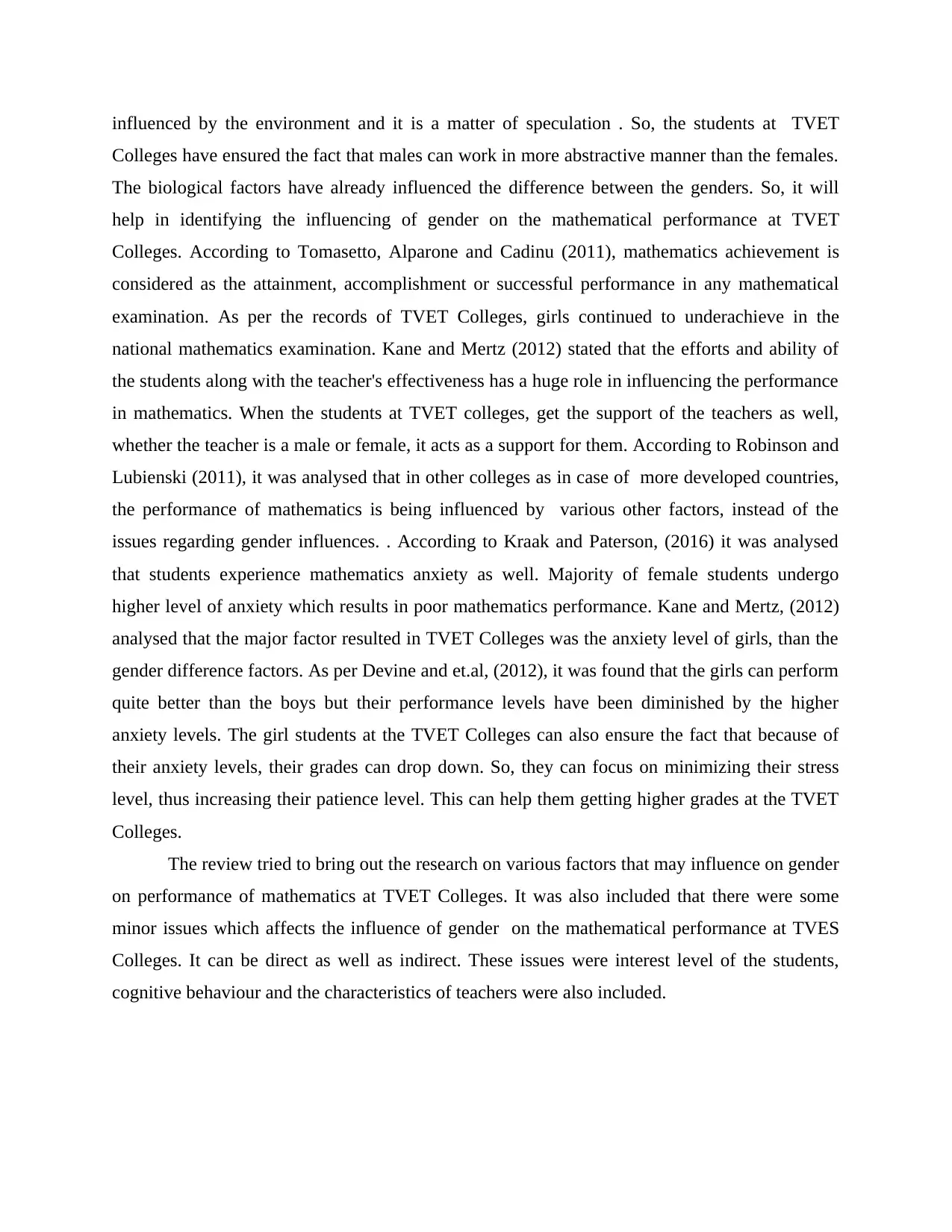
influenced by the environment and it is a matter of speculation . So, the students at TVET
Colleges have ensured the fact that males can work in more abstractive manner than the females.
The biological factors have already influenced the difference between the genders. So, it will
help in identifying the influencing of gender on the mathematical performance at TVET
Colleges. According to Tomasetto, Alparone and Cadinu (2011), mathematics achievement is
considered as the attainment, accomplishment or successful performance in any mathematical
examination. As per the records of TVET Colleges, girls continued to underachieve in the
national mathematics examination. Kane and Mertz (2012) stated that the efforts and ability of
the students along with the teacher's effectiveness has a huge role in influencing the performance
in mathematics. When the students at TVET colleges, get the support of the teachers as well,
whether the teacher is a male or female, it acts as a support for them. According to Robinson and
Lubienski (2011), it was analysed that in other colleges as in case of more developed countries,
the performance of mathematics is being influenced by various other factors, instead of the
issues regarding gender influences. . According to Kraak and Paterson, (2016) it was analysed
that students experience mathematics anxiety as well. Majority of female students undergo
higher level of anxiety which results in poor mathematics performance. Kane and Mertz, (2012)
analysed that the major factor resulted in TVET Colleges was the anxiety level of girls, than the
gender difference factors. As per Devine and et.al, (2012), it was found that the girls can perform
quite better than the boys but their performance levels have been diminished by the higher
anxiety levels. The girl students at the TVET Colleges can also ensure the fact that because of
their anxiety levels, their grades can drop down. So, they can focus on minimizing their stress
level, thus increasing their patience level. This can help them getting higher grades at the TVET
Colleges.
The review tried to bring out the research on various factors that may influence on gender
on performance of mathematics at TVET Colleges. It was also included that there were some
minor issues which affects the influence of gender on the mathematical performance at TVES
Colleges. It can be direct as well as indirect. These issues were interest level of the students,
cognitive behaviour and the characteristics of teachers were also included.
Colleges have ensured the fact that males can work in more abstractive manner than the females.
The biological factors have already influenced the difference between the genders. So, it will
help in identifying the influencing of gender on the mathematical performance at TVET
Colleges. According to Tomasetto, Alparone and Cadinu (2011), mathematics achievement is
considered as the attainment, accomplishment or successful performance in any mathematical
examination. As per the records of TVET Colleges, girls continued to underachieve in the
national mathematics examination. Kane and Mertz (2012) stated that the efforts and ability of
the students along with the teacher's effectiveness has a huge role in influencing the performance
in mathematics. When the students at TVET colleges, get the support of the teachers as well,
whether the teacher is a male or female, it acts as a support for them. According to Robinson and
Lubienski (2011), it was analysed that in other colleges as in case of more developed countries,
the performance of mathematics is being influenced by various other factors, instead of the
issues regarding gender influences. . According to Kraak and Paterson, (2016) it was analysed
that students experience mathematics anxiety as well. Majority of female students undergo
higher level of anxiety which results in poor mathematics performance. Kane and Mertz, (2012)
analysed that the major factor resulted in TVET Colleges was the anxiety level of girls, than the
gender difference factors. As per Devine and et.al, (2012), it was found that the girls can perform
quite better than the boys but their performance levels have been diminished by the higher
anxiety levels. The girl students at the TVET Colleges can also ensure the fact that because of
their anxiety levels, their grades can drop down. So, they can focus on minimizing their stress
level, thus increasing their patience level. This can help them getting higher grades at the TVET
Colleges.
The review tried to bring out the research on various factors that may influence on gender
on performance of mathematics at TVET Colleges. It was also included that there were some
minor issues which affects the influence of gender on the mathematical performance at TVES
Colleges. It can be direct as well as indirect. These issues were interest level of the students,
cognitive behaviour and the characteristics of teachers were also included.
Paraphrase This Document
Need a fresh take? Get an instant paraphrase of this document with our AI Paraphraser
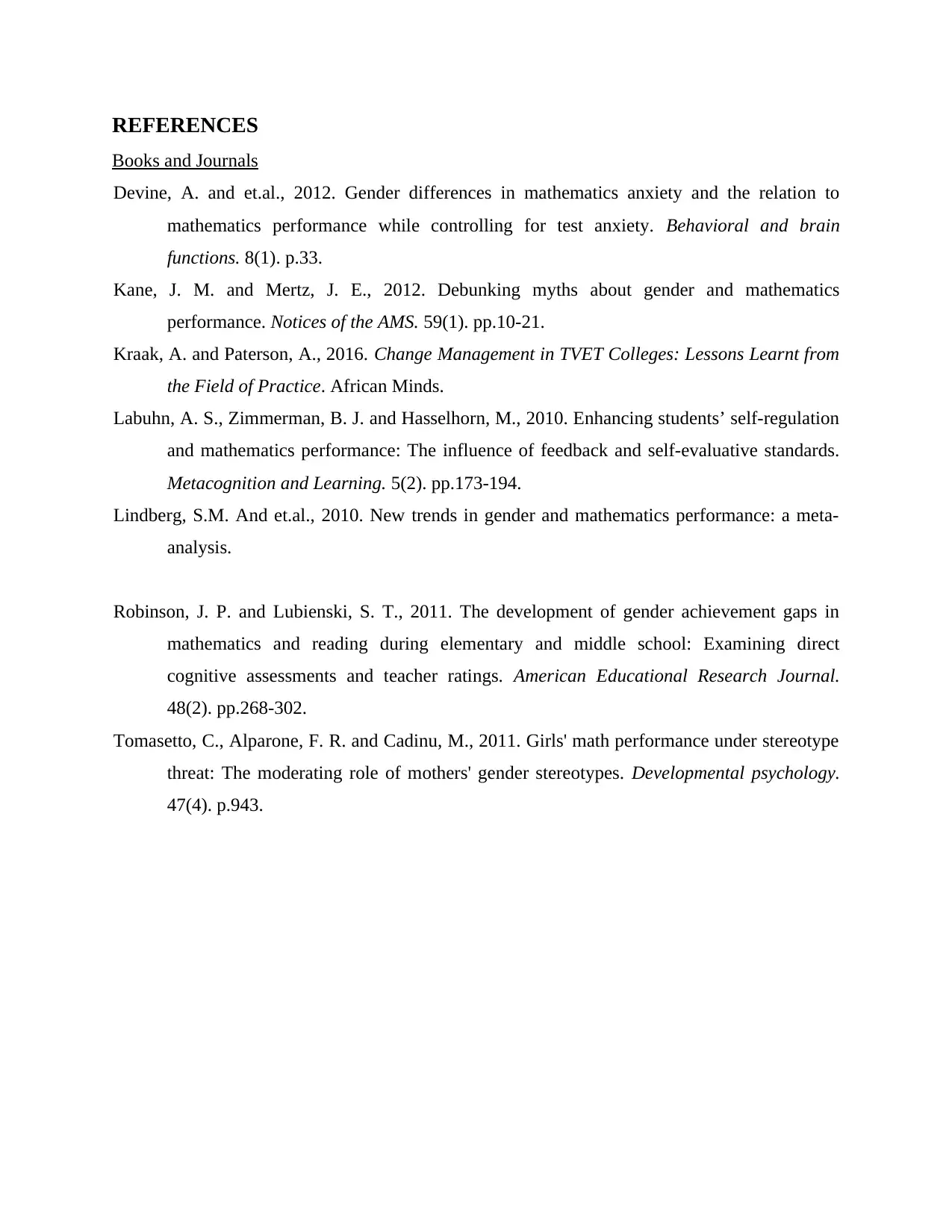
REFERENCES
Books and Journals
Devine, A. and et.al., 2012. Gender differences in mathematics anxiety and the relation to
mathematics performance while controlling for test anxiety. Behavioral and brain
functions. 8(1). p.33.
Kane, J. M. and Mertz, J. E., 2012. Debunking myths about gender and mathematics
performance. Notices of the AMS. 59(1). pp.10-21.
Kraak, A. and Paterson, A., 2016. Change Management in TVET Colleges: Lessons Learnt from
the Field of Practice. African Minds.
Labuhn, A. S., Zimmerman, B. J. and Hasselhorn, M., 2010. Enhancing students’ self-regulation
and mathematics performance: The influence of feedback and self-evaluative standards.
Metacognition and Learning. 5(2). pp.173-194.
Lindberg, S.M. And et.al., 2010. New trends in gender and mathematics performance: a meta-
analysis.
Robinson, J. P. and Lubienski, S. T., 2011. The development of gender achievement gaps in
mathematics and reading during elementary and middle school: Examining direct
cognitive assessments and teacher ratings. American Educational Research Journal.
48(2). pp.268-302.
Tomasetto, C., Alparone, F. R. and Cadinu, M., 2011. Girls' math performance under stereotype
threat: The moderating role of mothers' gender stereotypes. Developmental psychology.
47(4). p.943.
Books and Journals
Devine, A. and et.al., 2012. Gender differences in mathematics anxiety and the relation to
mathematics performance while controlling for test anxiety. Behavioral and brain
functions. 8(1). p.33.
Kane, J. M. and Mertz, J. E., 2012. Debunking myths about gender and mathematics
performance. Notices of the AMS. 59(1). pp.10-21.
Kraak, A. and Paterson, A., 2016. Change Management in TVET Colleges: Lessons Learnt from
the Field of Practice. African Minds.
Labuhn, A. S., Zimmerman, B. J. and Hasselhorn, M., 2010. Enhancing students’ self-regulation
and mathematics performance: The influence of feedback and self-evaluative standards.
Metacognition and Learning. 5(2). pp.173-194.
Lindberg, S.M. And et.al., 2010. New trends in gender and mathematics performance: a meta-
analysis.
Robinson, J. P. and Lubienski, S. T., 2011. The development of gender achievement gaps in
mathematics and reading during elementary and middle school: Examining direct
cognitive assessments and teacher ratings. American Educational Research Journal.
48(2). pp.268-302.
Tomasetto, C., Alparone, F. R. and Cadinu, M., 2011. Girls' math performance under stereotype
threat: The moderating role of mothers' gender stereotypes. Developmental psychology.
47(4). p.943.
1 out of 5
Your All-in-One AI-Powered Toolkit for Academic Success.
+13062052269
info@desklib.com
Available 24*7 on WhatsApp / Email
![[object Object]](/_next/static/media/star-bottom.7253800d.svg)
Unlock your academic potential
Copyright © 2020–2025 A2Z Services. All Rights Reserved. Developed and managed by ZUCOL.